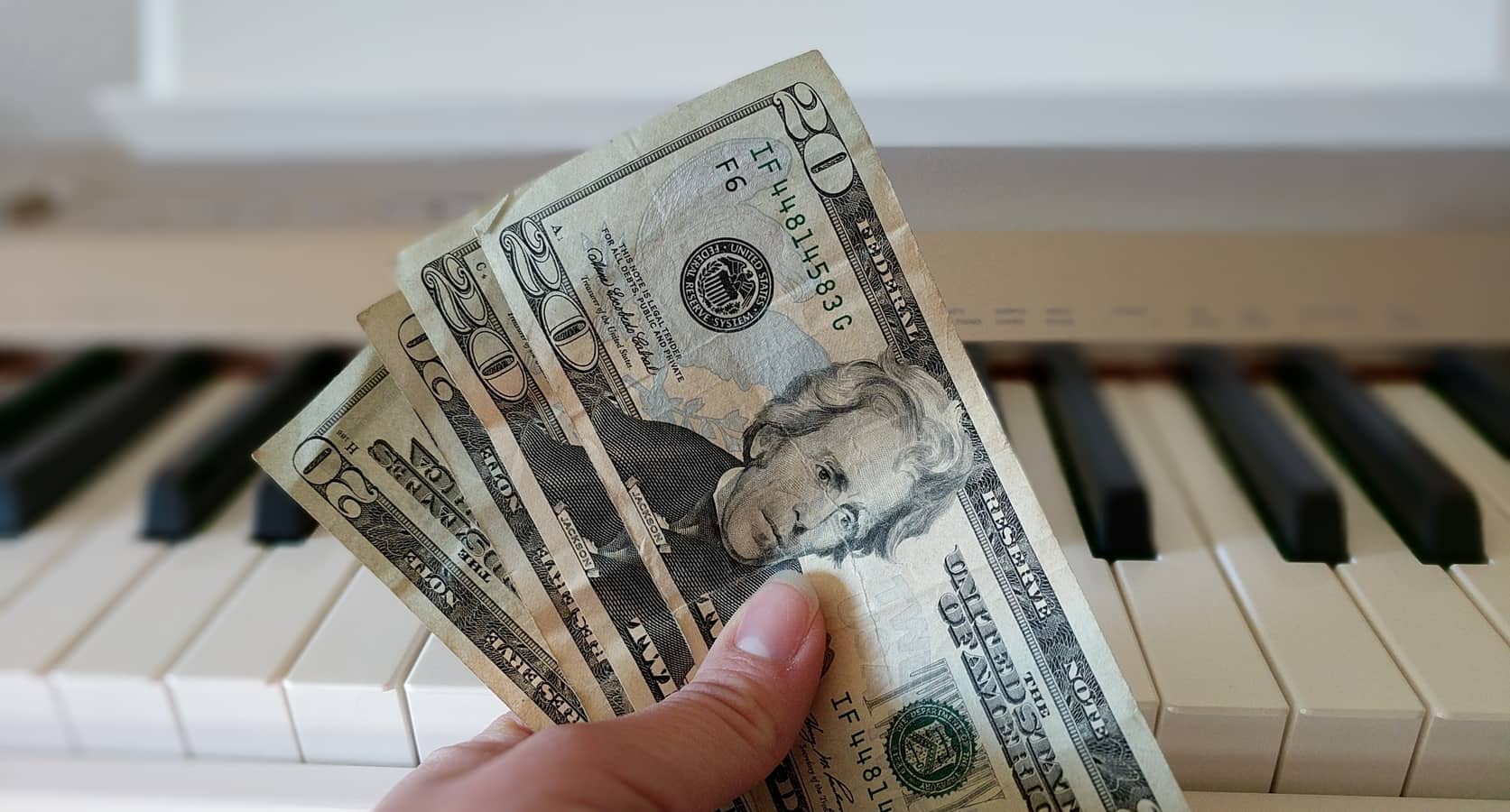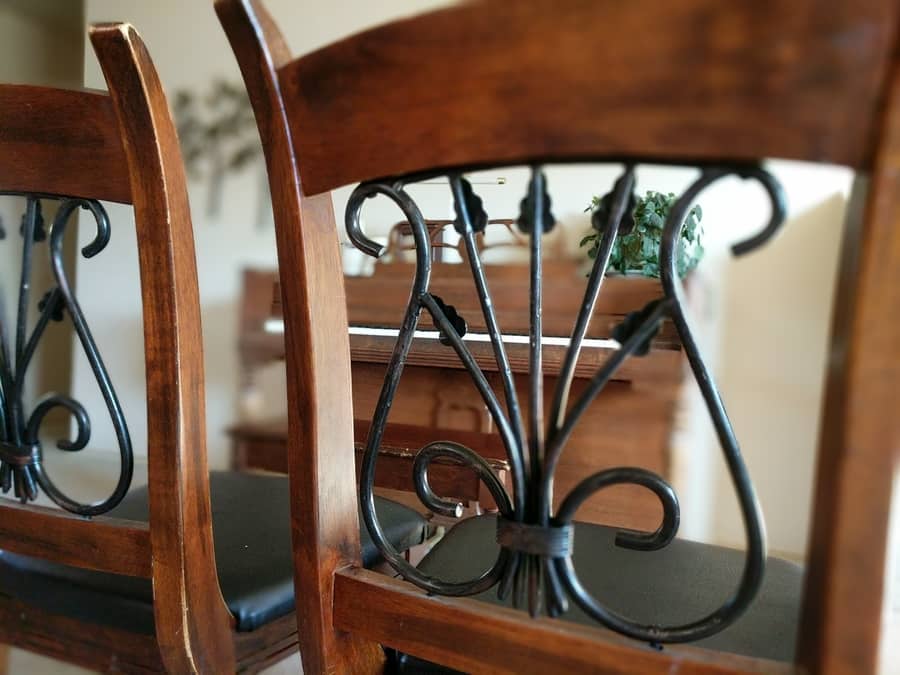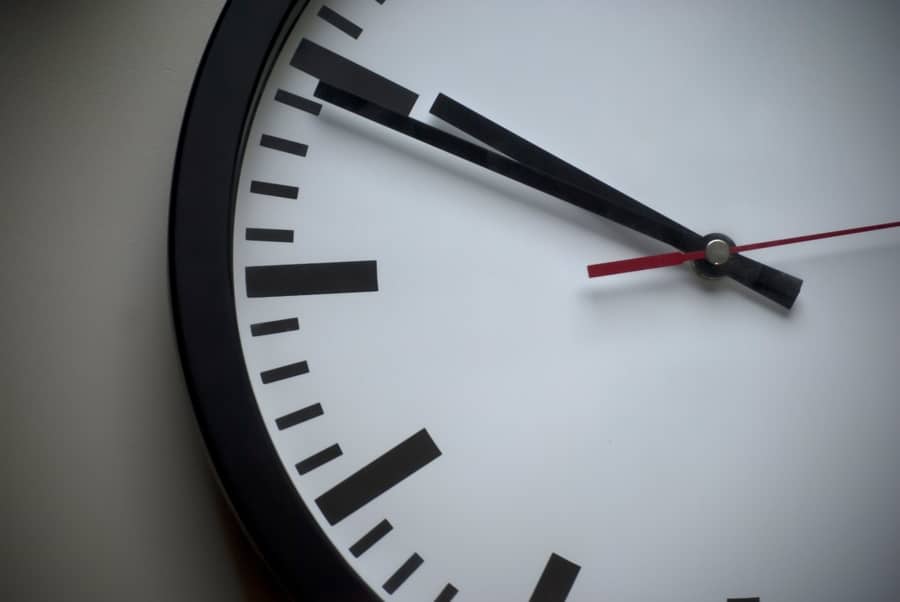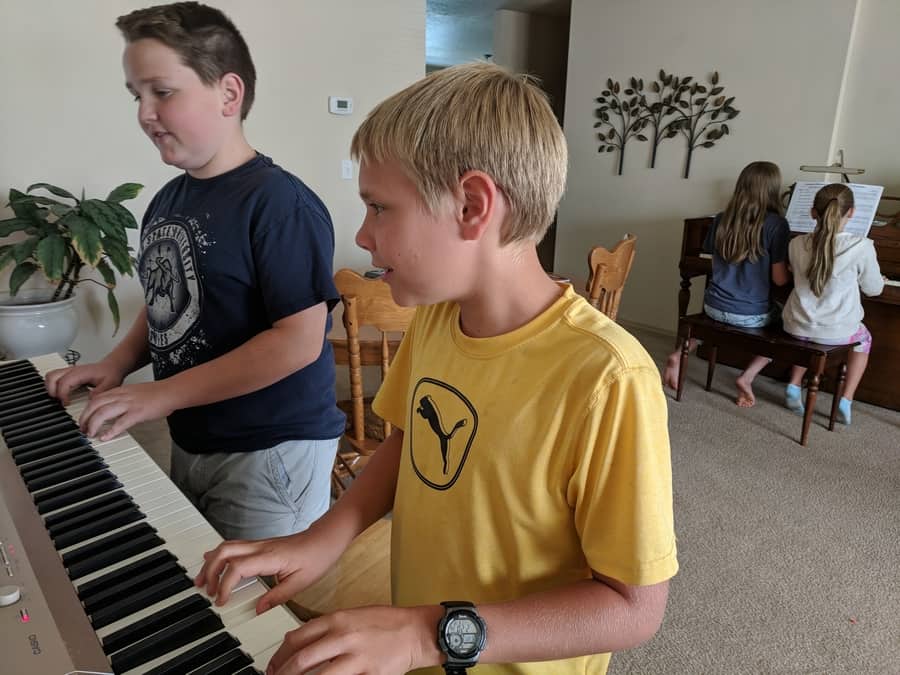
One of the first things a piano teacher needs to figure out is how much to charge. You want to be able to offer lessons affordably, but you also need to make sure that the work and other cost of material and time that you are putting in is worth it to you!
How much should I charge for piano lessons? On an average, a piano teacher charges between $15-25 per half hour lesson or $50-100 per month. The following chart displays how much piano lessons cost for 30 minute lessons.

These numbers are affected by several other contributing factors. This a good jumping off point, but add in the additional factors and then you will find the right price to charge.
*Please note that this data was compiled based off of comparing about 100 different sources from around the United States.
Contributing Factors to Adjust Your Price
Experience is a large contributing factor to how much you can charge a student. The more experience you have, the more you have to offer. Experience can include how many years you have taught piano, how many years you have played piano, who your previous teachers may have been, where you were educated, and any certification, awards, or acknowledgements you have may have received. All of these items add value to your lessons, and that can increase the price you can charge.
Location is another contributing factor. Larger cities, in general, have a greater demand for music teachers and naturally, the price of lessons increase. In places where piano teachers are scarce and hard to come by, piano teachers can charge more. If you are in a location where piano teachers are not in as much need, or there is not a great interest in gaining that skill, you won’t be able to charge as much. Calling local teachers and studios around your specific location can be a way to estimate your local median price.
- In a study from Take Lessons that you can find here, San Francisco had the most expensive private lessons in the United States (at $65 per hour lesson), followed by Boston and New York City (both at $60 per hour lesson).
- In that same study, Detroit and Portland had the lowest median price in the United States (at $40 per hour lesson), followed by Las Vegas (at $42 per hour lesson).
The age of the person taking lessons can also affect the price to charge. Older, more advanced students can require more time and expertise because potentially, the students will be more involved in competitions and performances to advance their education. Younger students may not require as much additional expertise, although teaching younger students – especially toddlers – most certainly takes skill!
Length of Lessons. Some teachers find it worthwhile to have piano lessons for a longer period of time. You could adjust your time within your lessons to 45 minutes, or an hour. The older the student, the easier it is to lengthen the lesson because their attention span will be longer. It is still very possible to have longer lessons with younger students, just be prepared to change activities and adjust as needs be so that the younger students stay engaged. Because you are adding in extra time, the amount you can charge can be greater.
Other Costs to Consider
Materials. Every teacher needs to build up their materials that they will need in their studio. Materials can include cost of keyboards (especially for group lessons with multiple students) and headphones. Any upkeep on the piano, such as tuning and maintenance, which can cost a minimum of $100/year. Poster boards or items to display, flashcards, materials for games/activities, large floor staff, any other instruments to supplement lessons (such as percussion instruments), and a bluetooth speaker are all items that you will likely need at some point in your lessons. Check out my piano studio must-haves as well as organizing your studio.
Gifts/Incentive Programs. Having an incentive program for practicing can bring in additional costs, even if the incentives are small. I am always suprised at how quickly I need to replenish my box of gifts for my students. Even if you aren’t planning on using an incentive program, appreciation gifts to the students need to be considered. As well as birthday or holiday occasions in which a little something could be appropriate for giving your students.
Travel Expenses. If you are planning on traveling to the student’s houses, then you definitely want to factor in the cost and the time of travel. Consider the gas as well as the wear and tear that the traveling will use on your vehicle. Teachers can charge an additional fee for travel, or just include that within the price that you charge.
Additional Fees You May Want to Charge For
Most extra-curricular activities charge additional fees in addition to the upfront cost. There are costs for costumes (such as dance), not to mention tickets to attend the concert. Sports have uniform fees and costs for attending games. You also have additional charges for piano lessons that you can consider charging the students for.
If you choose to charge an additional fee other than your lesson fee, make sure you let the students and their parents know well beforehand. You will have much less complaining if the parent is aware that this charge will occur. I would suggest a once a year fee for recitals, studio, and book fee. Keep that fee consistent so that it doesn’t throw the parents off when it is due again. Offer different ways to pay for the expense (such as adding in additional cost each month), if a one time fee is a problem.
Recital Fees: ranges from $20-50 Recital fees are very common. By the time you factor in the venue (which can cost around $200), the cost of the printed program, a trophy or other gift of achievement, and refreshments, you are well into an expensive enterprise. That doesn’t even include all the time you put into preparing for this! If you don’t want to charge for a recital, then consider doing a recital out of your home or another free venue. Depending on the amount of students you have, this may or may not be possible. You could opt to have more than one recital in order to be able to fit a smaller crowd into your space. Also, if you are wanting to avoid a recital fee, then make your gift to the students a little less pricey. The students can bring a treat which can also make it less expensive in general.

Studio Fee: ranges from $15-45 When registering for lessons, you may want to include a studio fee. Studio fees help the studio in purchases of materials for lessons, incentive gifts, and additional resources such as instruments, printing costs, office supplies, etc. The studio can be expensive to build up as well as maintain.
Book Fee: ranges from $10-50 As your students move through their books, they will need to purchase additional books to continue to progress. I always offer to purchase these for my students or I ask the parents if they would rather purchase it themselves. To help keep these costs down, I charge a one time “library” fee in which they can pay $20 for the privilege of checking out my books. I have built up several method books and additional materials that I loan out to the students. It the book is damaged, then the student is required to purchase that book for themselves so that I can replace it in my own library. This system has worked really well for my studio and my families appreciate not having to purchase all the books. Of course, there are certain books that my students want to have for themselves. These can either become gifts, or I allow the parents to purchase the books for their own households. These are my favorite selections of piano music that your students will love.
How Many Hours Are You Really Spending? Your True Hourly Rate

It is easy to think that if you charge $15 for a half hour lesson, that your hourly rate is $30. If all you ever did was teach hour long lessons, then that would be true! Honestly, that is just not realistic. You have hours of preparation, planning, ordering materials/books, preparing for recitals, etc. that are often not “logged”. So when you are considering just how much to charge your students, remember all of the time that goes into each lesson before you decide for sure what is worth it to you. The last thing you want to do is have a burnout because you are underpaid.
So what all goes into being a piano teacher? What kind of time commitment are we really looking at? Check out the following list:
- Teaching your lesson with the student (30-60 mins/week per student)
- Planning your lesson (30+ mins/week)
- Preparing materials for your lessons: flashcards, games/activities, ordering materials, etc. (15-60 mins)
- Researching ideas for your lessons (30-60+ mins)
- Any additional education, certification, or training you are receiving in relation to your piano teaching career (60-120 mins/week)
- Recital planning: reserving a venue, printing programs, preparing refreshments, preparing gifts for the students (3-4 hours)
- Personal practice time to maintain your skill (3+ hours/week)
- Personal performance time to maintain your skill and credibility (1-2 hours of performance)
- Travel time: traveling to and from students homes, travel to and from recitals and performances (varies)
- Keeping books: collecting payments, taxes for self-employment, keeping track of expenses, etc. (30+ mins weekly)
- Communication with parents (30+ mins weekly)
Realistically looking at the amount of time you are putting into being a piano teacher will help you determine what you feel is a fair price to charge for your student. There needs to be a balance of having lessons that are affordable for your students, but will also compensate for everything (time, money, and resources) that you are putting into it.
Should I Consider Discounts?
Sometimes, there can be discounts offered such as when a family has more than one child taking lessons from you. In my experience, I have found it easier to not offer family discounts or other discounts. If one student finds out that another student is being charged differently, it creates a mess. If you do offer discounts, make sure it is a hard fast rule that nobody can refute so that you won’t run into that issue between students and their families.
Sometimes I have students who truly do need some type of break from the expense of piano lessons. I don’t offer a discount on recital, studio, or book fees, but I will sometimes offer a trade on my “services” (meaning my monthly fee for lessons). I will trade a service for a service. Examples of services to trade for:
- Babysitting
- Prepared meals
- Other items they can offer such as fresh eggs, produce, bread, or items they can make or would like to trade
- Cleaning
- Other lessons, skills, or expertise they can share with you or your family
- Carpooling your kids
Please note that I do find it important to always have the students pay, or trade for lessons. A student who is not required to pay will not take lessons seriously and you will find that they may begin missing lessons here and there, or quit practicing, or just take it as a free ride. I have had students who were not charged for their lessons and it always ended in disaster. They need to pay, or sacrifice somehow for their lessons or they will not get the same out of it as those who do. Taking lessons is an investment and you take away that investment and they won’t get anything out of it.
Cost Comparison of Group vs. Individual Lessons
In my research that I have done for this article, I have found that there is minimal difference between the cost of group lessons versus individual lessons. The charge is slightly less, sometimes not even a difference at all.
If you have group lessons, then the cost benefit is much, much greater than individual lessons. Having four students who pay $40/month (which is a minimum amount), would give you $160 for that same amount of time you would have been spending with just one student.
Having group lessons also allows you to have more students because you are spending less time, and thus you have a greater income. For example, it would be 4 hours of your time to work with 8 students for 30 minute lessons each. With that same 4 hours, you could have 4 hour long classes with 4 students in each class, and thus have 16 students total. Double the amount of students to work with in the same amount of time, and double the income.
One thing to consider with group lessons, is that you will need more materials. You will need multiple pianos, headphones, office supplies, flashcards, etc. Those materials would cost more to supply initially, so that does need to be taken into consideration.
If you are considering group lessons, head on over to my post on How to Teach Piano: Full Lesson Plans and All You Need for the first year of teaching piano. These are fun, interactive lessons that can get you going on your group lessons.

Suggestions on How and When to Charge Your Students
When? Once you decide how much you are going to charge a month, the most important thing you must do next is figure out how you will accept payment and when. By far, the best time to accept payment is at the beginning of every month. I charge a flat fee per month, even if they end up getting 5 lessons instead of 4 lessons in that month. If you accept payment at each lesson, there will be times that either you or they will forget to pay. And who wants to sit there and ask for payment every single lesson? Much better to ask for it just once a month and be done.
Even better, you can offer a slight discount if they are willing to pay upfront for several months. Taking the year into “semesters” such as Fall Semester, Winter Semester, and Summer Semester, you can charge per semester. It is ideal if they pay once and then they don’t have to think about it again for a while.
The other benefit to having them pay a month in advance, is so that they are less likely to miss or forget a lesson. If they have already paid for a lesson, and then they double schedule themselves, that would be there own doing – they have already paid for it anyway! I do like to show a little mercy if a lesson is missed. I offer a one time reschedule. I get that life happens and in case something happens on my end that I need to cancel a lesson, I would appreciate mercy on their end as well.
How? Oh I am so grateful for technology! My life has gotten so much easier since Google Pay and Venmo has come into existence! People can pay me on the spot as I remind them it is the beginning of the month. I would accept check or cash, but 90% of my students prefer just to pay me through Venmo or Google Pay. If those aren’t your preferred forms of payment, there are many others, including Square. If you haven’t gotten into payment through these methods yet, then I highly suggest you should. It is so much easier to collect payment this way and to keep record in case they think they have already paid you and they haven’t.
Related Questions?
How Often Should I Raise My Rates? Music lessons increase in rate at an average of 5% per year. Check your local rates on a yearly basis to determine how your lessons compare with the local prices around you.
How Much Are Online Piano Lessons? Online piano lessons can vary from $15 – $125. Options vary considerably for online lessons. If you are willing to be unorganized in your piano learning and be mostly self-taught, there are plenty of YouTube videos you can watch that will teach you the basics for free.
Tel loves her life as a piano player, a piano teacher, and a mom. Amid piano blogging, piano teaching, and piano playing, she loves a chance to fit in a good exercise class, volunteer at her kids’ school and at her church, and go on long dates with her husband. Full bio at About Tel.



This was all very good information. Thank you for sharing your knowledge and expertise in teaching piano. It is greatly appreciated.